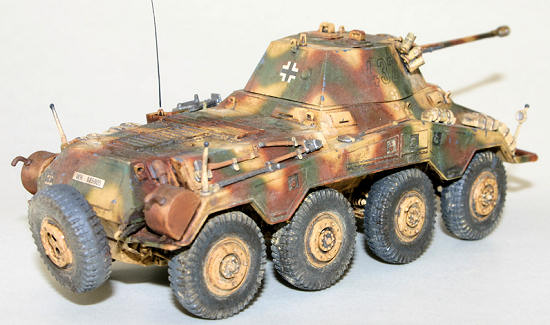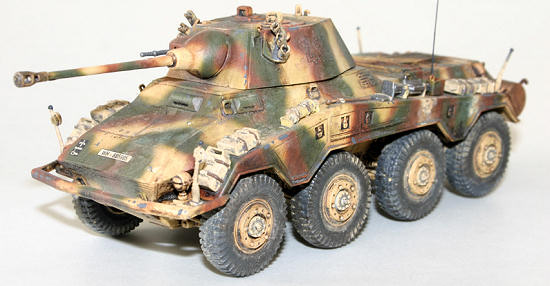Italeri 1/48 Sd.Kfz 234/2 "Puma"
|
KIT #: |
6601 |
|
PRICE: |
14.00 Euros
|
|
DECALS: |
Four options |
|
REVIEWER: |
Pierre-André Boillat |
|
NOTES: |
A
welcome “first” in that scale |

The Sd.
Kfz. 234 family of eight-wheeled armoured vehicles were the successors of the
previous, successful 232 series, with improvements in matters of armour,
motorization and ease of
production.
The resulting series would turn out to be WWII’s finest reconnaissance armoured
vehicles and would inspire similar designs in many countries, until our days.
The
series consisted of the reconnaissance Sd.Kfz. 234/1 (the most numerous),
equipped with a “Hängelafette” open
turret and a 20mm cannon, the open-topped 234/3 infantry support armed with a
short 75mm gun, the (equally open-topped) 234/4 tank hunter with its PAK 40 AT
gun, and the most famous of the lot, today’s subject, the 234/2 “Puma”.
 The
Puma’s most recognizable feature is its turret, taken from the cancelled VK 1602
“Leopard” light tank, which itself should have been a successor to the “Luchs”
(lynx) reconnaissance tank, but proved too complicated and expensive to produce
for too little an improvement.
The
Puma’s most recognizable feature is its turret, taken from the cancelled VK 1602
“Leopard” light tank, which itself should have been a successor to the “Luchs”
(lynx) reconnaissance tank, but proved too complicated and expensive to produce
for too little an improvement.
This
well-designed, streamlined turret was armed with a 50mm KwK 39/1 L/60
high-velocity gun that was more than enough to deal with enemy light tanks and
could hurt much heavier foes. Add the Puma’s sloped armour and whooping top
speed of 85 Km/h (53 mph) – in forward and reverse gear, as it had two driver
positions – and you got an armoured vehicle that had to be taken seriously by
any adversary.
Only
101 Sd. Kfz.234/2 Pumas were produced between September 1943 and September 1944
(the other versions were easier to produce, though less effective in the
vehicle’s intended scouting role), to the chagrin of the shrinking Panzer
divisions which could never get enough. As a result, the few, precious existing
ones were treated with utmost care and did distinguished service until War’s
end.
This is Italeri’s third military vehicle kit in 1/48, and the very first Puma
in
that scale. As the company had produced nice 1/35 models of the whole 234 series
during the eighties, my impression is that this one is a scaled-down version of
its larger ancestors.
 When
you open the box, you’ll first be surprised by the size of the thing. The Puma
was not a small vehicle – in fact, it was larger than many medium tanks. Once
finished, it makes a rather majestic impression even in quarter scale.
When
you open the box, you’ll first be surprised by the size of the thing. The Puma
was not a small vehicle – in fact, it was larger than many medium tanks. Once
finished, it makes a rather majestic impression even in quarter scale.
Moulding
is crisp with almost no flash to speak of, and the presence of basic interior
detail (which isn’t needed here) shows that the rest of the family is likely to
follow some day. Surface detail and small parts are a tad below Tamiya
standards, but decent enough in my opinion (by the way, the famous Japanese
company is going to release it under its own name). Part count is reasonable,
fit is more than OK, the result being a beautiful kit that assembles in one
week-end if you wish so.
Decals
are provided for four vehicles which sport different camo options, one being
plain sand yellow (which is good if you have no airbrush).
As said
above, fit is good and no putty was necessary, though the rather soft plastic
required the lager parts to be taped together while the glue dried. As usual, I
built the kit in sub-assemblies (wheels, body, turret) to facilitate painting,
and left the small gear (jerry cans, tools, rear-view mirrors etc) for the end.
T he wheels
are plastic, not rubber (good idea!), no metal parts are included, and the kit
also lacks figures. A commander
could have been nice, but it’s a matter of taste, and at the kit’s rather low
price (at least in
Europe),
one cannot complain. The inner details being left aside (in fact, I put them in,
unpainted), construction went very quickly and in one afternoon, the Puma was
ready for painting.
he wheels
are plastic, not rubber (good idea!), no metal parts are included, and the kit
also lacks figures. A commander
could have been nice, but it’s a matter of taste, and at the kit’s rather low
price (at least in
Europe),
one cannot complain. The inner details being left aside (in fact, I put them in,
unpainted), construction went very quickly and in one afternoon, the Puma was
ready for painting.
Of the
four proposed schemes, I chose the one I found the most original (with a “low
viz” individual number left in black outlines only), representing a vehicle of
20th Panzer Division in
Czechoslovakia,
1945. A mix of
Vallejo
(basic sand yellow) and Tamiya acrylics (olive and reddish brown camo) were
used. Decals are of excellent quality and went on without problems. Then, I
applied a dark brown oil wash, which was later worked on with a soft brush and
white spirit.
The
many jerry cans, board tools and other fiddly bits were pre-painted and added
last, then got a light wash of thinned enamels to “blend into the picture”.
A light post-shading was made to give the paint job additional life,
followed by some powdered
 pastels to
represent the dust, dirt and rust. A method I like is to spray random drops of
water over the pastels, which gives the impression of faded, stained paint.
Lastly, I added tiny re-touches of paint with a small brush, the result looking
a bit exaggerated under the flashlight and the magnifying glass-effect of the
camera lens, but very convincing when looked at under normal light.
pastels to
represent the dust, dirt and rust. A method I like is to spray random drops of
water over the pastels, which gives the impression of faded, stained paint.
Lastly, I added tiny re-touches of paint with a small brush, the result looking
a bit exaggerated under the flashlight and the magnifying glass-effect of the
camera lens, but very convincing when looked at under normal light.
This
easy and well-made kit perfectly recaptures the sleek, aggressive shape of this
beautiful vehicle, and will provide any modeller with a rewarding experience.
It’s a perfect “first project” for those who’d like to try an armour kit, but
fear tracks.
Highly
recommended to all.
PS:
Where I live, though it was first released in January, I haven’t seen the
Italeri 1/48 Puma anywhere yet (mine was ordered from an online shop), so this “Achtrad”
made quite an impression when I showed it at my latest club meeting. Apparently,
it’s not been produced in large quantities, so check your favourite hobby shops
– or wait for the Tamiya release. As for myself, I’m looking forward to the
other 234’s.
TNT
(Trucks and Tanks Magazine) special # 7 : Les véhicules de reconnaissance de
l’Axe.
Waffen
Arsenal # 96 : Puma und andere Panzerspähwagen der ARK-Reihe.
Various
internet research.
Pierre-André Boillat
June 2011
If you would like your product reviewed fairly and fairly quickly, please contact the editor or see other details in the Note to
Contributors.
Back to the Main Page
Back to the Review
Index Page




 he wheels
are plastic, not rubber (good idea!), no metal parts are included, and the kit
also lacks figures. A commander
could have been nice, but it’s a matter of taste, and at the kit’s rather low
price (at least in
he wheels
are plastic, not rubber (good idea!), no metal parts are included, and the kit
also lacks figures. A commander
could have been nice, but it’s a matter of taste, and at the kit’s rather low
price (at least in  pastels to
represent the dust, dirt and rust. A method I like is to spray random drops of
water over the pastels, which gives the impression of faded, stained paint.
Lastly, I added tiny re-touches of paint with a small brush, the result looking
a bit exaggerated under the flashlight and the magnifying glass-effect of the
camera lens, but very convincing when looked at under normal light.
pastels to
represent the dust, dirt and rust. A method I like is to spray random drops of
water over the pastels, which gives the impression of faded, stained paint.
Lastly, I added tiny re-touches of paint with a small brush, the result looking
a bit exaggerated under the flashlight and the magnifying glass-effect of the
camera lens, but very convincing when looked at under normal light.